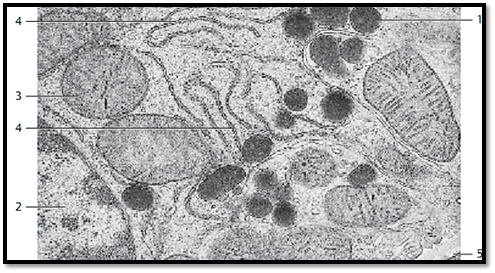


 النبات
النبات
 الحيوان
الحيوان
 الأحياء المجهرية
الأحياء المجهرية
 علم الأمراض
علم الأمراض
 التقانة الإحيائية
التقانة الإحيائية
 التقنية الحيوية المكروبية
التقنية الحيوية المكروبية
 التقنية الحياتية النانوية
التقنية الحياتية النانوية
 علم الأجنة
علم الأجنة
 الأحياء الجزيئي
الأحياء الجزيئي
 علم وظائف الأعضاء
علم وظائف الأعضاء
 الغدد
الغدد
 المضادات الحيوية
المضادات الحيوية|
Read More
Date: 17-1-2017
Date: 19-1-2017
Date: 2-8-2016
|
Peroxisomes
In 1965, C. de Duve discovered peroxisomes in liver cells. J. A . Rhodin had previously described them as “microbodies.” They are small, spherical organelles with a diameter of about 0.2–1.5 μmm, which are ubiquitous in cells. Peroxisomes have a single membrane as their outer border. Their finely granular or homogeneous content is electron-dense. Occasionally, peroxisomes enclose paracrystalline materials. Peroxisomes are respiratory organelles. They contain various oxidases, catalase and the enzymes for the β-oxidation of fatty acids. Peroxisomes owe their name to their peroxidative enzyme content. They play an important role in the detoxification of cells. Example: the enzyme catalase will split hydrogen peroxide, a lethal cell poison. Genetic diseases that are based on peroxisomal defects include Zellweger syndrome , Ref sum syndrome and adrenoleukodystrophy . Section from an epithelial cell (human liver) with two peroxisomes of different sizes.
1 Section through a mitochondrion
2 Smooth endoplasmic reticulum (sER) membranes
3 Areas with cellular glycogen (glycogen removed)

Section through a mouse epithelial cell from a proximal kidney tubule with several peroxisomes, which are rich in catalase 1 .
1 Peroxisomes
2 Nucleus (partial section)
3 Mitochondria (crista-type)
4 Granular ER (rER) membranes
5 Peritubular connective tissue space

References
Kuehnel, W.(2003). Color Atlas of Cytology, Histology, and Microscopic Anatomy. 4th edition . Institute of Anatomy Universitätzu Luebeck Luebeck, Germany . Thieme Stuttgart · New York .



|
|
|
|
دراسة يابانية لتقليل مخاطر أمراض المواليد منخفضي الوزن
|
|
|
|
|
|
|
اكتشاف أكبر مرجان في العالم قبالة سواحل جزر سليمان
|
|
|
|
|
|
|
اتحاد كليات الطب الملكية البريطانية يشيد بالمستوى العلمي لطلبة جامعة العميد وبيئتها التعليمية
|
|
|